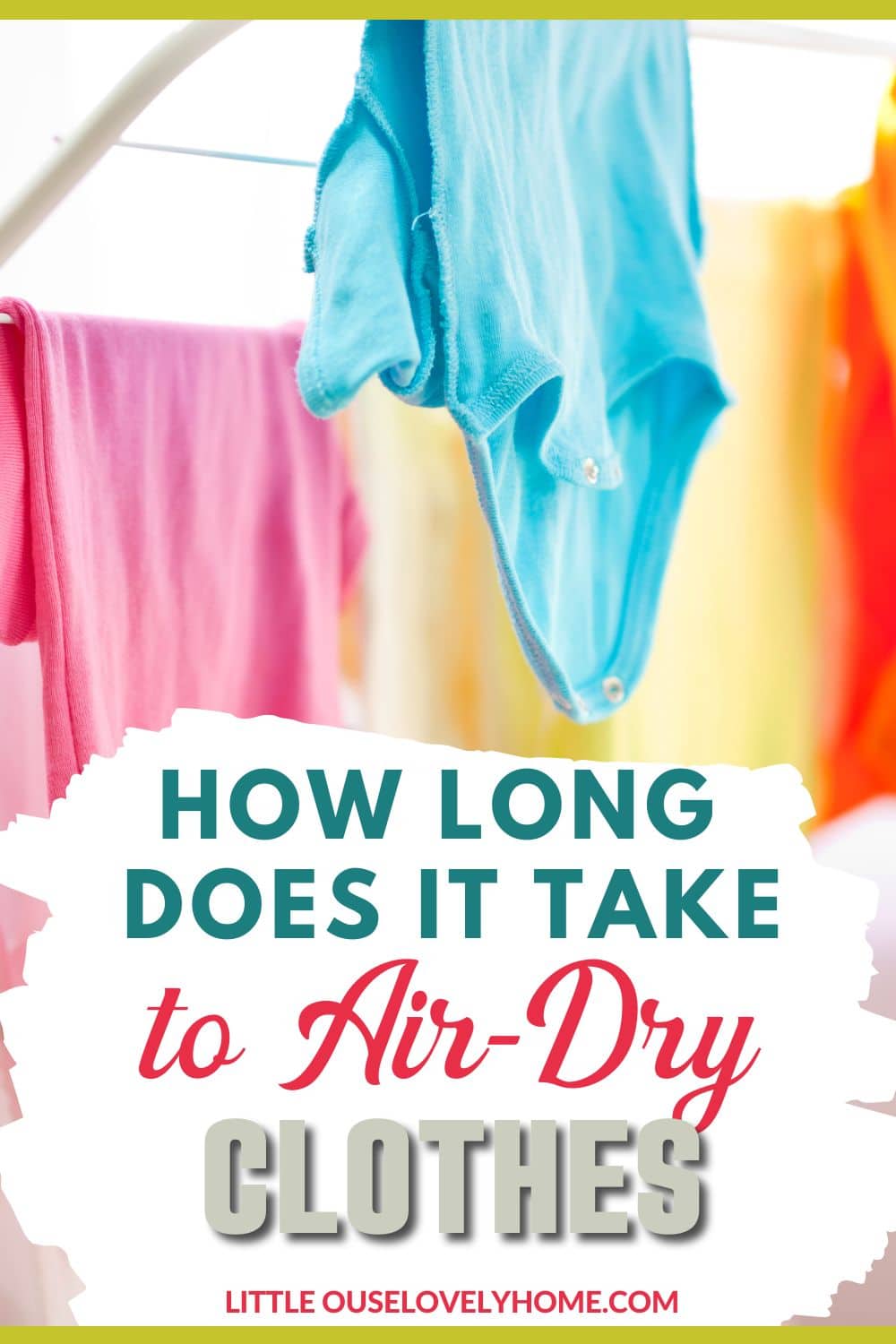There are plenty of benefits to air-drying your clothes. It can help them last longer, save you money on your energy bill, and be better for the environment.
But one of the biggest questions people have is, “How long does it take to air-dry my clothes?”
The answer to that question depends on a lot of factors, including the type of fabric, the weight of the fabric, the humidity in the air, and the temperature. But in general, you can expect most clothes to take between two and four hours to air-dry.
So, if you’re looking to save some money or reduce your carbon footprint, air-drying your clothes is a great option.
Just be sure to factor in some extra time when you’re planning your laundry routine.

Table of Contents
- How Long Will It Take To Air-Dry Clothes?
- Factors That Affect the Drying Process of Air Drying Wet Clothes
- Does Air Actually Dry Clothes?
- Does a Fan Dry Clothes Faster?
- Does the Air Fluff Cycle Dry Clothes?
- Why Are My Clothes Stiff After Air-Drying?
- What Is the Fastest Way to Dry Clothes?
- Benefits of Air Drying Wet Clothes
- The Bottom Line
How Long Will It Take To Air-Dry Clothes?
As mentioned above, on average, you can expect it to take approximately two to four hours for your clothes to naturally dry.
This means that your clothing will be dry to the touch, including areas with thicker fabric such as pockets or cuffs.
However, some clothing items or accessories such as towels can take much longer than 4 hours to dry.
For items that will hold more water and are larger, such as blankets or towels, it may take up to 24 hours for them to fully dry.
In order to predict the exact drying time, there are several factors you’ll need to take into account:
Factors That Affect the Drying Process of Air Drying Wet Clothes
Here are some of the most common factors that will change the speed and quality of your line drying:
The Type of Fabric
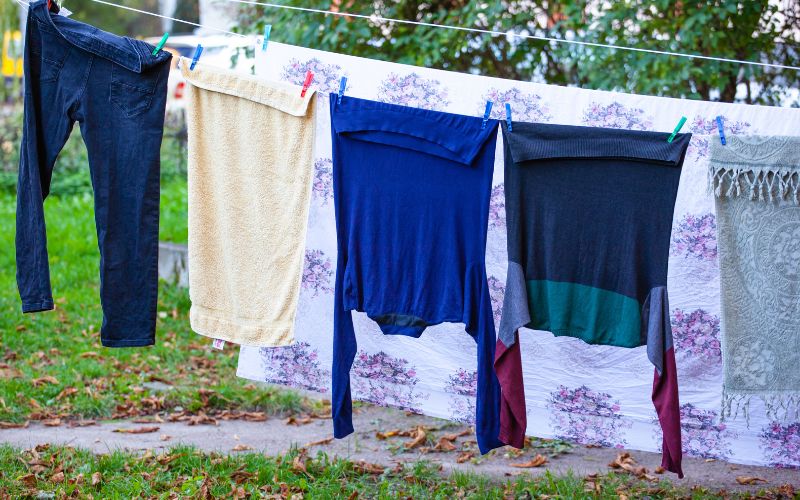
Firstly, you’ll want to consider the type of fabric you’re drying. Different materials will absorb water differently and, as a result, will dry at different rates.
For example, natural fibers such as cotton or linen will take longer to dry than synthetic fabrics like polyester.
This is because natural fibers are more absorbent than synthetic ones.
The Weight of the Fabric
The weight or thickness of the fabric will also affect drying time. A lightweight cotton shirt will dry faster than a heavy denim jacket, for example.
This is because thicker fabrics take longer to absorb heat and moisture, which is necessary for the drying process. There may also be folds or creases in the fabric that trap moisture and prevent it from evaporating.
The Temperature and Humidity of the Room
The temperature and humidity of your drying environment will also play a role in how quickly clothes dry.
For instance, if you’re drying clothes in a hot, humid room, they’ll take longer to dry than if you’re drying them in a cool, dry room.
This is because warm air can hold more moisture than cold air, and humid air will prevent clothes from losing moisture.
The Airflow in the Room
Finally, you’ll want to consider the airflow in the room where you’re drying your clothes.
If there’s good airflow, such as from a fan or an open window, the clothes will dry faster. This is because the moving air will help evaporate the water more quickly.
How You Hang the Clothing to Dry
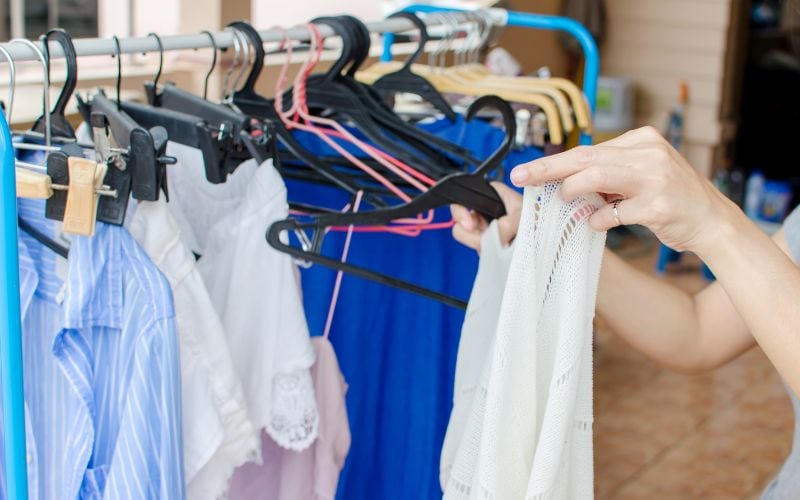
The way you hang your clothes can also affect the drying time.
For instance, if you hang them on a line or rack in a single layer, they’ll dry faster than if you pile them on top of each other.
This is because the air can circulate more easily around the clothing when it’s not crowded.
You should also avoid hanging wet clothes on metal hangers, as this can rust the hangers and transfer the rust to your clothing.
Indoors or Outdoors
Another factor to consider is whether you’re drying your clothes indoors or outdoors.
Generally speaking, clothes will dry faster outdoors because there’s more airflow and sunlight.
However, this isn’t always the case, so you’ll need to take into account the other factors mentioned above as well.
Does Air Actually Dry Clothes?
Yes, air drying will fully dry your clothes with some time and patience. In fact, when you’re using a drying machine, the air is one of the most important things that help clothes dry.
The air in the machine circulates around the clothing and carries away moisture.
With heat alone, your dryer can’t actually dry clothing. It just makes the water evaporate more quickly.
This is why air-drying is often considered a gentler way to dry clothing, as it doesn’t subject them to the high temperatures of a dryer.
Does a Fan Dry Clothes Faster?
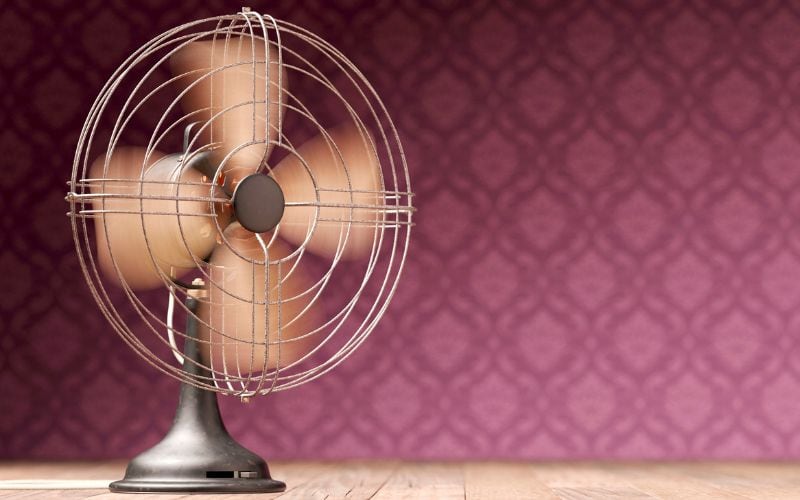
A fan is a great way to dry your clothes more thoroughly and quickly. You can use any kind of fan you have around your home, including a desk fan, a box fan, or an oscillating fan.
The air from the fan will help evaporate the water from your clothes more quickly, and it will also help circulate the air in the room so that the clothes dry evenly.
This emulates the natural breeze of outdoor air when you’re drying clothes indoors.
In order to correctly set up your fan to dry clothes, you’ll want to place it in front of an open window. This will create a cross-breeze that will help the clothes dry even faster.
You can also use a ceiling fan if you have one. Just make sure that the blades are spinning in the correct direction (usually counter-clockwise) so that they create a downward draft.
Try to position your fan just far enough so that it can reach all of your clothes without being too close. You don’t want the fan to blow directly on your clothes, as this can cause them to wrinkle.
If you’re trying to dry wet spots on your clothing, try using a hair dryer. Set it to the lowest heat setting and hold it about six inches away from the fabric. Move it around until the spot is dry.
This method could cut hours out of the line drying process without damaging your clothing.
Does the Air Fluff Cycle Dry Clothes?
The air fluff cycle was made so that you could dry delicate items without them getting damaged or tangled.
The cycle works by using neutral room temperature air to fluff up the clothes and help them release any wrinkles or creases. Your clothes dryer won’t spin as quickly to avoid damaging any delicate fabrics.
However, the air fluff cycle doesn’t speed up the drying process, and it will take a lot longer than a regular cycle to dry your clothes.
You can either use the air fluff setting to help your fabrics lay nicer before air-drying clothes, or you can use it to fluff up any wrinkled clothing that you need to wear right away.
It’s possible to let your delicates stay in the air fluff load for about an hour and they will dry naturally from the air circulation. However, especially if you have a full load of laundry, this can take several hours.
Why Are My Clothes Stiff After Air-Drying?
When you air-dry clothes indoors, sometimes you’ll notice that they’re left with a stiff feeling.
This is usually because you’ve used too much laundry detergent during the wash cycle and there is still residue on your clothing.
This can also happen if you don’t have any airflow, which can cause the clothes to dry stiffly because they don’t have any movement to help release the stiffness.
If your clothes are stiff after air-drying, you can try rewashing them with less detergent or fabric softener. You can also try hanging them back up and running a fan nearby to help circulate the air and release any stiffness.
Finally, you can place them in the dryer on the air fluff mode if they are sturdy enough to withstand the tumbling, which will help release any stiffness from the fabric.
What Is the Fastest Way to Dry Clothes?
The fastest method for air drying clothes is to do your laundry in the most ideal conditions.
You can hang your clothes to dry outdoors on a drying rack or on a clothing line. Choose a bright, dry, and pleasantly warm day. The air temperature should be at least 70 degrees.
This will allow your clothes to dry much faster than if you air-dried them indoors on a humid or cool day.
If it’s not possible to hang your clothes outside, you can also try using a fan indoors to help circulate the air and speed up the drying process.
The most important part of this process actually has very little to do with drying.
Make sure to focus on getting as much moisture out of your clothing in the first place to dramatically reduce time when air-drying clothing.
How to Remove Moisture From Wet Clothing
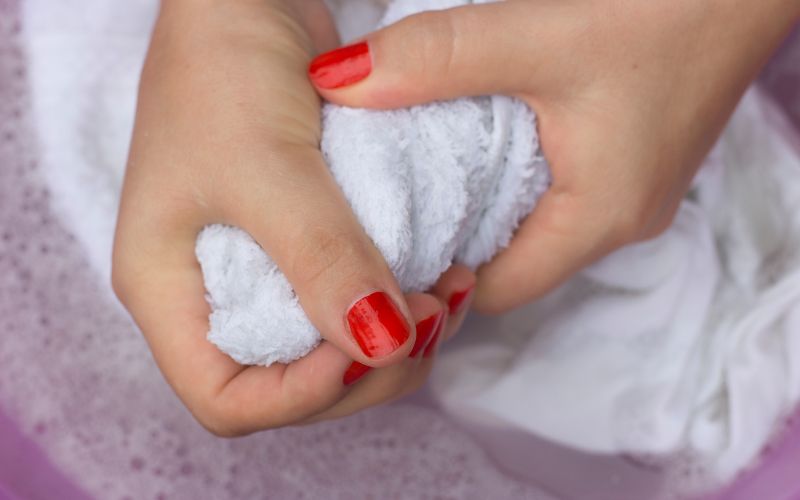
You can make sure your clothes are damp instead of dripping wet by rolling them in a towel. This will help to remove any excess water before you hang them up to dry.
Start by laying your wet clothing item on a dry towel. Then, roll the towel up with the clothing inside. The goal is to get as much water out of the fabric as possible so that it will air-dry faster.
Use a lot of pressure when you’re rolling the towel so that more water is absorbed. Once you’ve rolled up the wet clothing item in the towel, wring out the towel to remove any extra water.
This will help to remove any excess water before you hang them up to properly hang dry.
You can also try using a salad spinner to get rid of moisture in your clothing. This is especially helpful for very small and delicate items that can’t go in the wringer. Just don’t make sure they’re too delicate!
To use a salad spinner, first, place your wet clothing item in the basket. Then, close the lid and spin the handle to start removing water.
The centrifugal force will help to remove any excess moisture from your clothing so that it can air-dry faster.
When you’re finished, open up the salad spinner and remove your now damp clothing item to hang dry.
Benefits of Air Drying Wet Clothes
Since air drying clothes takes more time than using a hot air drying machine, why would you choose to air dry? Here are some of the main benefits of air drying clothes:
- It will make your clothing last longer: Many fabrics are sensitive to high heat and over time they will fray or become misshapen. If you want your clothing to last longer, air drying is the way to go.
- It’s more energy-efficient: Air drying clothes takes less energy than using a hot air dryer, which means it’s better for the environment and your wallet.
- It prevents shrinking: Clothes that are air-dried are less likely to shrink than those that are dried in a hot air dryer.
- It’s a great option for traveling: If you’re going on a trip and don’t have access to a dryer, air drying is the next best thing. This can save you precious time and money when you’re on the adventure of your dreams.
The Bottom Line
While it will take a bit more time when air drying your clothes, it will be worth it in the long run. Your clothes will last longer, you’ll save money, and your clothes won’t shrink.
Air drying is also a great option when you’re traveling and don’t have access to a dryer. So next time your clothes are wet, consider air-drying them instead!
